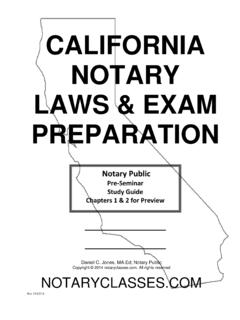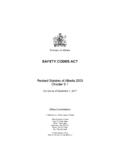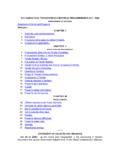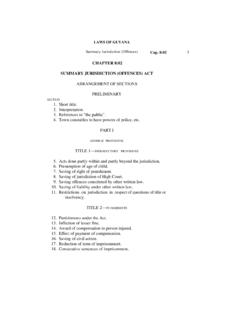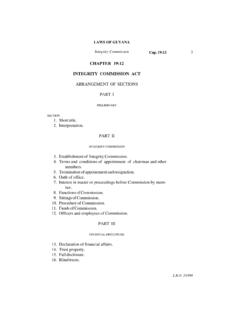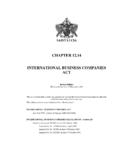Transcription of CHAPTER 4 Completing the Notary Act Chapter …
1 29 CHAPTER 4 Completing the Notary Act CHAPTER Objective: This section will further elaborate several of the duties of a Notary public and provide information as to how these duties may or must be performed. The student will have an opportunity to complete an Acnowledgment form. They will also understand more thoroughly the details of specific Notary acts. Part 1 Acknowledgments and Jurats Without a question, the two most often performed duties of a Notary are known as taking or Completing an acknowledgment and administering jurats . When a client is required to have a document notarized, that document will usually require a Notary to either complete an acknowledgment or administer a jurat. The Notary will usually know which is required because the document to be notarized will usually have the indication or the signer may already know.
2 Interestingly enough, the Notary is not allowed to select which act is performed because to do so may place the Notary in a position of illegally practicing law. When a client brings a document to a Notary , if the proper verbiage is not preprinted on the form indicating which Notary act to perform, the Notary is supposed to ask the client which Notary act he or she requires. If the client does not know, then the Notary is to require the client to obtain an answer from the originators of the document. Completing acknowledgments In a nutshell, this notarial act means that the person who signed the document to be notarized must 1) personally appear before the Notary at the time of the Notary request and 2) must acknowledge that he or she signed the document in his or her authorized capacity, ( CEO, Partner, individual) and 3) the document signer(s) must be properly identified by the Notary .
3 If the Notary is required to complete an acknowledgment, the document may be signed by the principal(s) at the time of notarization or may have been signed prior to appearing before the Notary . If it has been signed prior to bringing the document before the Notary , the Notary must ask the signer to acknowledge that the signature is indeed his or hers. Whether the document was signed previously or in front of the Notary , the Notary is required to verify the identity of the person or persons signing a document either through personal knowledge or with satisfactory evidence such as a driver s license. When a document signer places his or her signature on a document, the Notary must assume that the signer intends to execute the document. California Notary law does not require a Notary to verify the competency of the document signer nor is the Notary required to make judgments concerning whether or not the document signer is being coerced in some manner.
4 If the document signer insists that the Notary notarize his or her signature, then regardless of suspicions, the Notary must comply with that request. State law prohibits non-attorney notaries from giving legal advise or providing legal assistance of any kind. The Notary is obligated to notarize the document if requested by the 30document signer and the signer can present proper identification as well as the required fees. Although very often violated in practice, it is an absolute legal requirement that the Notary be able to speak the language of the signer. If a person signing a document cannot communicate to the Notary in a language that the Notary understands, the Notary must refuse to notarize that document. The signer should be directed, if possible, to another Notary who does speak their language.
5 Utilizing an interpreter brought in by the client is not allowed since that interpreter might have ulterior motives and render an inaccurate translation or something may be lost in the translation itself. Proper acknowledgment verbiage Proper notarization includes the requirement that the Notary fill out specific information in a particular format. This is known as Notary verbiage and is usually, but not always, found pre-printed on the document itself or will be attached to the document. In California, it is illegal for a Notary to place the Notary seal on any document not containing notarial verbiage. As stated earlier, the document to be notarized will usually require either an acknowledgment or a jurat. These two Notary acts are quite different from one another and will have associated verbiage which will be immediately recognizable by the Notary .
6 As we continue through this CHAPTER , you will be introduced first to proper acknowledgment verbiage and then to proper jurat verbiage. Do not worry! Once you complete this CHAPTER , you will immediately be able to recognize which Notary act to perform for any document containing proper notarial verbiage. Remember that if a document contains no notarial verbiage at all, the Notary must ask the client to inform him or her of which Notary act he or she requires. When someone brings a Notary a document to notarize, the Notary should first look the document over to ensure that it is not blank or incomplete as it is illegal to notarize blank or incomplete documents. If the document is blank or incomplete, return the document to the client for completion. Remember that you as a Notary may never give legal advice so filling out the contents in the document for the client can be illegal.
7 The second piece of information to look for on the document is if the proper Notary verbiage is already printed on the document. Depending on the type of documents you will be notarizing, most documents will already have Notary verbiage on the form and will need to fill this portion out and seal it with your Notary stamp. However, many documents either do not have proper verbiage or will not have any Notary verbiage pre-printed on the form. If there is no Notary verbiage preprinted on the form, you will need to add the verbiage. If you need to add acknowledgment verbiage to a document, you will use an additional form called an All-Purpose Acknowledgment form. An example of an All-Purpose Acknowledgment can be found on page A-1 in the back of this manual. All California notaries should carry these forms because many documents do not have the proper verbiage for California.
8 For an example of a typical document requiring an acknowledgment, please turn to page A-2 which is a Grant Deed. Once again, someone requiring this document to be notarized will already have it filled in completely prior to presenting it to you for notarization. It is not important that the Notary be familiar with every kind of document requiring notarization as that would be rather impractical. There are hundreds if not thousands of different documents out there. Simply look the document over to ensure that 31it is not obviously blank or incomplete. The only portion that may be incomplete is the Notary verbiage which begins: The State of _____, County of _____. This is the section the Notary begins Completing once the signature or signatures are obtained. If it has not been signed, request the signature or signatures of the clients prior to Completing this section.
9 How to fill out an acknowledgment Acknowledgment verbiage is very important especially with documents to be filed in California. All documents requiring a Certificate of Acknowledgment taken within the state of California, and especially those to be recorded in California should contain the following verbiage: STATE OF __CA_____ COUNTY OF (Name of County in which the Notary act occurred) On (Date of Notary Act) before me, ( Notary s name as on the commission ), Notary Public (Name/Title, Jane Doe, Notary Public) Personally appeared (Name of person(s) acknowledging their signatures at the time of notarization) personally known to me (or proved to me on the basis of satisfactory evidence) to be the person(s) whose name(s) is/are subscribed to the within instrument and acknowledged to me that he/she/they executed the same in his/her/their authorized capacity(ies), and that by his/her/their signature(s) on the instrument the person(s), or the entity upon behalf of which the person(s) acted, executed the instrument.
10 WITNESS my hand and official seal. ( Notary Seal) (Notice that your signature is placed underneath this phrase, not just anywhere on the document) _____ (SIGNATURE OF Notary ) Once again, please refer to the example of this on the Grant Deed found in the appendix section of this book, page A-2. As the Notary , you will begin Completing this notarial verbiage by filling in the state and the county in which you are physically located at the time of notarization. This portion of the acknowledgment is called the venue. STATE OF __CA_____ COUNTY OF (Name of County in which the Notary act occurred) Many mobile notaries travel to different counties when Completing a Notary act.




